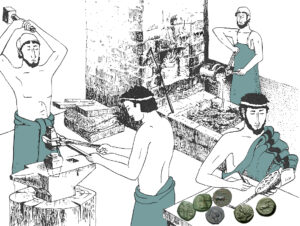In the context of ancient numismatics, the Punic one studies the coinage of the Phoenician tradition that developed in the West between the end of the V century BC and the time of Caligula. The wide time span in which this monetary experience develops makes the discipline a broad, complex and in some way “transversal” field of research, not attributable in other words to a single political entity and a single cultural environment: the oldest findings of this phenomenon, in fact, are born and developed in Sicily fueled by the inevitable confrontation with the Greek world and its evolved monetary and economic system; the later results, the neo-Punic coinage, inherit and keep alive the tradition of Carthage still in the middle of the Roman-imperial era.
 The area affected by Punic coin production is also large: the oldest nucleus represented by Carthage and the Punic Sicilian and Sardinian regions, at the fall of the metropolis is dilated up to the mining centers of Beturia Turdula in the Iberian Peninsula and North-Africa, up to the Tripolitan emporia to the East and West up to the city of Sala on the Atlantic coast of Morocco.
The area affected by Punic coin production is also large: the oldest nucleus represented by Carthage and the Punic Sicilian and Sardinian regions, at the fall of the metropolis is dilated up to the mining centers of Beturia Turdula in the Iberian Peninsula and North-Africa, up to the Tripolitan emporia to the East and West up to the city of Sala on the Atlantic coast of Morocco.
Punic coins therefore significantly mark the limits of Phoenician influence in the West and in some cases, represent the only evidence of the Punic presence in a given city or area.
The complexity of the monetary phenomenon of the Phoenician tradition in the West is not comprehensible if the role of Carthage is not adequately highlighted, which between the first half of the fourth century BC.C. and 146 BC.C., develops an imperialist policy that includes, among other things, the control and management of the coin production of the entire basin of the Punic Mediterranean.
The metropolis becomes, in fact, the only issuing authority that determines the monetary policy in the controlled territories, interrupting a previous city tradition, which re-emerges autonomously only after its fall.
In this context, the Punic coinage is divided into three phases: a) the coinage of the autonomous cities of Sicily prior to the imperialist rise of Carthage; (b) the coins of Carthage and its provinces; c) the coinage of the autonomous cities and neo-European kingdoms developed after the fall of Carthage.
